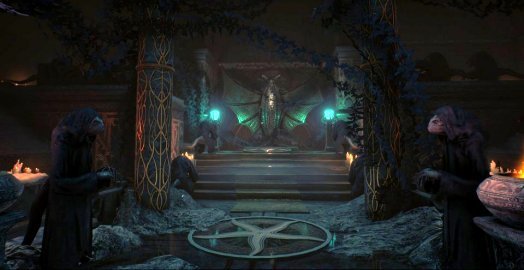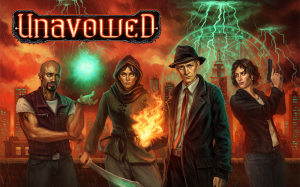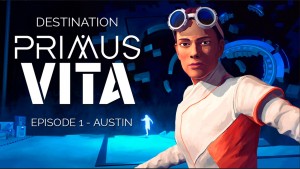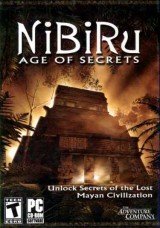Review for Conarium

It occurred to me a few years ago when I played a Lovecraft-themed Portal clone that the gaming scene had possibly reached peak Lovecraft, after which any passing reference to his work in popular media would tend to trigger the cynical centers of my brain (which are admittedly on a hair-trigger, anyway). But despite my grumpiness about the persistent onslaught of cosmic horror-related baubles, I was fairly jazzed to learn about the existence of Conarium, whose developer, Zoetrope Interactive, possessed a legitimate pedigree, having cranked out a couple of Lovecraftian adventure games almost a decade ago, before it became nauseatingly fashionable. While they weren’t at the top of my list when it comes to the renowned author’s games (those would be Call of Cthulhu: Dark Corners of the Earth and Sherlock Holmes: The Awakened, for which I make zero apologies), I maintain a soft spot for the pair of Darkness Within games. Even if their stories were only marginally coherent, they captured the forlorn mood and essence of the Lovecraft oeuvre infinitely better than shoving in a couple of tentacles, name-dropping Cthulhu and calling it a day. For that reason, I was secretly hoping for The Darkness Within 3: Loath Nolder’s R’lyehan Holiday, but I was happy to settle for Conarium, so long as it followed in the same footsteps.
Whereas the earlier games were set up more as straightforward mysteries dancing around the edges of Lovecraft mythos, Conarium (which is unrelated to its predecessors, aside from an Easter Egg) doesn’t mess about and dives headlong into the eldritch murk. Positioned as a sort-of-but-not-really follow-up to the novella At the Mountains of Madness, you take on the role of a scientist in a mid-20th century expedition to the Antarctic, sent to explore another series of cryptic ruins lying beyond the eponymous mountains. This implies that the Elder City discovered in the book, home to ancient beings that slaughtered or otherwise drove the last party insane, is somehow considered passé at this point, which I thought was a pretty ballsy opening gambit. Surprisingly, then, when the game begins, you awake with no memory (sigh) in an abandoned research outpost, and you’re left to sort out how things could have gone so unpredictably awry.
Despite having a good whack at the dead horse with its premise, Conarium’s narrative is otherwise pretty on-point. The developers obviously know their Lovecraft lore and draw heavily from it but still manage to tell their own story in that universe without feeling like a Force Awakens-style retread – although if you do need that sort of thing, there’s no shortage of direct references and hidden nods, most of them fortunately subtle enough that you don’t necessarily feel like the game is elbowing you in the ribs while saying “hey, see what I did there?” The problem is that for all the right notes it hits, playing through this story is a bit of slog. Almost everything else about the experience, from the graphics to the gameplay, just feels…meh.
On a technical level, the visual design is okay, even bordering on good. Conarium is built on the Unreal Engine 4, which usually means a game will look perfectly fine, unless the developers really don’t know what they’re doing, but not exceptional, unless the developers really know what they’re doing. My biggest gripe about UE games is always the damned lighting, where every single surface tends to reflect light like it’s made of stainless steel, which is unhelpful when 95% of the game is set in the dark and you constantly need to use a flashlight. It’s especially annoying when you’re trying to read notes from your in-game journal; it’s too dark to read without a light, but then when you do switch on your light, the reflection from the “paper” makes it too bright to read.
That quibble aside, my real complaint with the graphics is that everything looks a bit too generic. I can forgive that the research base at the beginning might appear a little unremarkable, although for some reason it stood out to me as having a more distinctive look than the rest of the locations, if only because it stuck in my head that the wood paneling and Art Deco décor seemed suspiciously unnecessary for a presumably temporary outpost in the middle of the Antarctic. But assuming that the research team was just eccentric or overly fussy, the main issue is that the marquee setting – the deeply-shunned and unholy subterranean ruins where you spend about two-thirds of the game – are generally bland. If I were being pedantic, I’d say I didn’t come across much that could be described as particularly cyclopean or non-Euclidean, as was the Elders’ wont. In fairness, there are a few nice set pieces punctuating the filler here and there, but most of the time I just felt like I was wandering through the same nondescript spooky cavern that I’ve been through in any number of other games of its ilk.
This didn’t necessarily ruin the experience for me, but it does drain a lot of atmosphere from the setting. The requisite ominous score, on the other hand, hits just the right notes (insert restrained chuckles here) with a sparse bit of woodwinds, discordant bells and chimes that ebb and flow along the way. (For what it’s worth, I don’t have an especially trained ear; they could have used a pipe organ and maracas for all I know.) The soundtrack is moody and menacing in just the right turns, without becoming overbearing. Regardless, even with sinister flutes proclaiming my doom, I eventually started to lose interest in my surroundings, and instead of creeping forward, wary of what lay ahead, I was running around instead, looking for something interesting to do.
And this is where Conarium really begins to sputter, because there’s just not that much to do throughout roughly five hours of spelunking. There are only a couple of what I would consider genuine, head-scratching puzzles throughout the game, and even those aren’t especially taxing. While you have an inventory you can collect and mess about with, you’ll never have more than a handful of items at any given time, two of those being your flashlight and walkie-talkie (which you never need to actively “use”). But there’s also not much to interact with, so the inventory “puzzles” are similarly trivial, since there’s never really a lot of imagination involved in sorting out what to use where or when.
There are a few spots where you’re actually in mortal danger, none of which feel particularly engaging or require anything more than basic motor skills to overcome. (Thankfully, there’s no real penalty for dying; you’ll pick up again just before you bit it.) Even then, I tried really hard to give the game the benefit of the doubt and look for some compelling angle. In one encounter, I died at least a handful of times running around looking for a place to hide or something clever to use to foil my pursuers, but in the end it turned out that I just needed to run in a big circle around them and back through the door I came in from. And that’s sorta emblematic of the rest of the adventure as a whole. As much imagination as I believe went into developing the story, it doesn’t feel like half as much went into anything else.
That’s a shame, because it starts out well enough: when I was trying to piece together who I was and what my character was all about, with occasional glimpses of a spectral-looking stalker darting out of view, I was feeling the right combination of mystery and tension. But once I made my way into the ruins, the suspense started to dry up (I already had the broad strokes of the plot sorted out by then) and the rest of the time was spent basically walking down corridors, broken up with the occasional vision/flashback, solving a perfunctory puzzle here and there, and picking up breadcrumbs – the requisite scattered loose documents and audio logs – to fill in the backstory until I reached the end of the line.
When I finally did, I found there are technically “multiple endings”, but only of the sort where the game stops just before the finale and gives you the choice between doing A or B. It’s a shallow and lazy game gimmick completely devoid of stakes or context, since both decisions/outcomes are completely transparent, draining them of any real sense of consequence (compared to a Telltale game where they at least try to give you the illusion that your choices have made a profound impact on the story). It’s trivially easy to peg the “real” ending vs the alternate, wholly unfulfilling, cut-to-credits ending. For what’s it worth, I went back to my save and tried the alternate ending on the off-chance that my hubris was misplaced, but it was not, and I wouldn’t recommend bothering with it unless you really need the Steam achievement.
Even before that, I never really felt like I was an active participant throughout most of the story, but more like I was on an Old Ones guided tour, brought to you by the Miskatonic Valley Chamber of Commerce. It didn’t help that in a handful of spots, you have a vision of one of your colleagues who kindly describes what you’re looking at. I’m almost tempted to say that this was meant to be a “narrative” adventure, but it doesn’t feel like it was meant to be, so calling it that feels like more of an excuse than a justification.
But even after I’ve shoved poor Conarium to the ground and kicked it a few times, I can’t bring myself to say that I actually disliked it. Some of my rancor comes from a profound sense of bitter disappointment, since I was going in with fairly high expectations. Given the almost decade-long lapse since Zoetrope’s last game, I want to believe this was just a case of the developer being a bit rusty and having an unfortunate mismatch of ambition and execution rather than a careless disregard for game design.
Towards the very end of the second Darkness Within game, there’s a point where you traverse a den of actual Lovecraftian horrors, but the entire event is relegated to a static illustrated screen and voice-over nonchalantly describing the cosmic terrors you’ve endured before resuming, none the worse for wear, on the other side. At the time I thought this was a hell of a thing to treat as a casual aside, but I understood that trying to turn it into something playable was way too ambitious and would have either overshadowed or wrecked the rest of the game. In a way, Conarium almost feels like an attempt to specifically make up for that one unplayable section, the end result actually serving more as a reminder of why it was probably a good idea to leave it out in the first place.
Regardless of intention, even though I think they've managed to put together a story and setting that fit nicely into the Lovecraft mythos without feeling painfully derivative (and despite my temptation to award the game an extra star for not trying to somehow shoehorn Cthulhu into the title), I just can’t recommend it in good faith to anyone other than a relatively devoted Lovecraft fan in need of a fix, and even then only if they keep their expectations in check. In the meantime, I’m hoping Zoetrope can get their feet under them a bit more, since now I’ll be patiently awaiting The Darkness Within: Loath Nolder’s Conarium Blues.
WHERE CAN I DOWNLOAD Conarium
Conarium is available at:
- GOG -80%
- Epic Games
- HumbleBundle




























